A social history in a book. Having been published twice each year since the 1890s, Kays catalogues represent a fascinating archive of the way we lived in the past. Not only are contemporary fashions included but there are also household items and luxury goods, thereby allowing the whole picture of life in past times to be examined.
The catalogue collection is now, once again, available for research purposes and is housed within the University of Worcester campus at St John’s and in the Hive in Worcester. Arrangements can be made to view the catalogues for genuine research purposes by contacting the University directly.
If you have any specific requirements for information then please Contact Us
Catalogue Pages
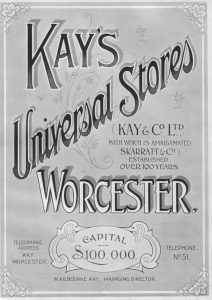
When the company first issued a bound catalogue in the late 1890s, the frontispiece and cover were a simple black and white graphic, as shown in this image of the 1907 catalogue cover. More colourful images of the products started to be used in the years just before WW1. The name of the company is given simply as “Kay’s Universal Stores, Worcester”. The Great Universal Stores company, which eventually bought Kays in 1937, was formed in 1902 by the Rose brothers in Ardwick, Manchester. The “Universal Stores” was a common name given to catalogue trading companies as they competed for market share by offering a very wide range of goods to their customers. The company telephone number is given as “51” on this catalogue and even up until 1975, the company used Worcester 29551 as its telephone number, retaining the “51” link back to the early 20th century.
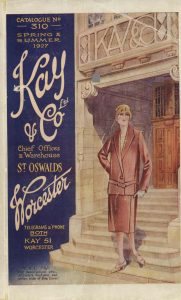
This is the cover of the Spring/Summer 1927 catalogue and is one of the few catalogue covers that features a Kays’ building, in this case, the front entrance of 23, The Tything. Known as St Oswalds by those who worked for the company, this building was designed and built for Kays and construction was completed in 1907. What is unusual about this image is the perspective used in the drawing of the model on the steps of St Oswald’s. It makes her over fourteen feet tall! The skirt suit featured on the cover was available at the price of 69/- (£3.45p), and that included the hat! Also intriguing to consider is the numbering of each catalogue issue. This one is numbered “310”, so although there were two main issues of the catalogue each year, and this tradition had been established in 1890, we can only wonder if Kays were trying to imply that they had been issuing two catalogues each year for the last one hundred and fifty-five years.
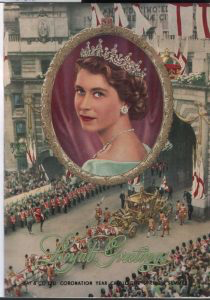
This wonderfully colourful and patriotic cover adorned the Coronation Celebration Spring/Summer Catalogue of 1953. This was a time of great optimism in Britain as a new Elizabethan age was predicted and after the hardships of the Second World War and the decade that followed it, the country revelled in the excitement that the Coronation brought. The catalogue features a range of gifts and toys that celebrated the Coronation. As part of its plans to expand its business activities and make its offices more local to its agents and customers, Kays opened new offices in both Leeds and Glasgow. They purchased a small Christmas club, called Samuel Driver Ltd, and amalgamated its operations into Kays. It was Driver’s offices and warehouse that became the centre of the northern operations.
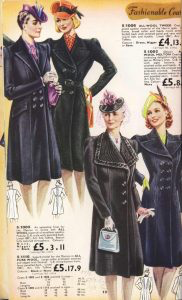
This page from one of the catalogues from the period of World War 2 illustrates how the well-dressed lady went out when visiting friends or just going out shopping. Unlike catalogues of today, the illustrations were drawn by Kays’ own graphic artists and are superb examples of their talent. The relative cost of the clothing in the 1940s surprises many, as our consumer society has made clothing a much more affordable commodity. The average weekly wage of a Kays’ office clerk in 1944 was 27/6 (£1.38), so the coats on this page represent a significant investment and as such could be paid for on the 20-week credit terms offered by the company to its customers.

Kays always sold a wide range of items and before the second World War the company had developed its own brand of teas. As late as 1959, Kays “Perfection” Tea was still featured in the catalogue. The trade name “Perfection” was also used for a range of pocket watches sold by the company from 1897 until 1919.
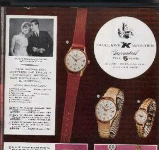
Students of social and fashion history find the catalogues a superb source of information on how we lived and dressed in the past.
Kays has always featured watches and clocks in its catalogues, as the company’s origin started in that trade. Watches were made by, and for, Kays in the early part of the 20th century but by 1965 other manufacturers were commissioned to produce Kays watches. This is a page from the Autumn/Winter 1965 catalogue with a selection of ladies and gentlemen’s watches. Such watches as these were often presented to staff as rewards for 25 years of continuous service to the company or as retirement gifts.
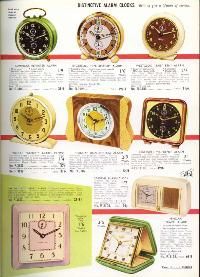
Collectors often ask for information as to how much items originally cost when they were first sold. Here is a page of clocks from 1956 showing the variety of styles available but also featuring an electric clock for the first time. The Kays catalogue collection covers over 120 years of shopping history and is a valuable source of information on design styles so that theatre, film and television designers can “get it right” when it comes to a 20th century period production.

Adults love to relive their own childhood by looking at the toys that they had as children. A recent research project (Spring 2005) was on the history of the Sindy doll and the catalogue collection enabled the researcher to document the life of Sindy from her first appearance in a Kays catalogue in 1963 to her last in 1990. This page from the AW 1965 catalogue is the first to feature Sindy and her friend, Paul.
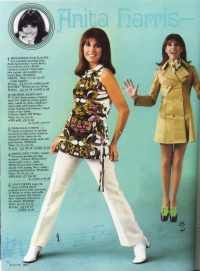
Kays have featured many famous singers, actors and celebrities in its catalogues over last forty years or so. This page from the Spring/Summer 1970 catalogue shows Anita Harris, the singer and entertainer, modelling her “collection”.
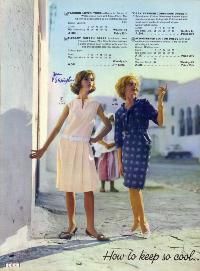
Some celebrities were, “before they were famous”, models in the catalogue. One of the joys of the research into Kays’ history is the discovery of an image from a known celebrity’s past. This page from the AW 1962 catalogue has a signed picture of Jean Shrimpton, who went on to become one of the leading fashion models of the 1960s. Renewed interest in jean Shrimpton because of a new BBC drama has been generated in January 2012.

This cover is from the Spring-Summer 1963 catalogue and is an example of how Kays and Worcester cathedral were associated with eachother during the 1960s and 1970s. The reverse of the current £20 note in circulation has a similar view of the magnificent cathedral. A similar view was used, albeit drawn to be a 18th century style, for the Royal Worcester pin dishes produced for Kays in 1965
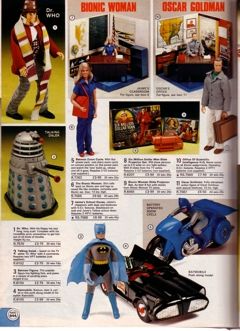
TOYS – Superheroes from 1977 ranged from the Bionic Woman, Batman and, the ever-popular, Dr Who. The Daleks have remained a part of popular culture since they were introduced in the 1960s and Kays featured many models of the Doctors’ sworn enemies. Batman has always been a popular fantasy hero with children of all ages and still has a strong market today. The range of merchandise associated with such brands has expanded enormously. Unfortunately, the Bionic Woman faded into obscurity (along with the Six Million Dollar Man) but in September 2007 she is making a come-back!

TOYS – Star Wars – The cult status of films such as “Star Wars” always presented an opportunity to feature toys on special display pages within the catalogue. This is a page of toys from “The Return of the Jedi”, the last of the original trilogy that featured in the Autumn/Winter 1984 catalogue. No doubt toy collectors wish they had bought these toys at the prices they were sold for in 1984, as some of the items featured are now very rare indeed.

The page from a later catalogue, shown below, features the last of the initial trilogy of Star Wars films “Return of the Jedi”.
TOYS – Star Wars – “The Return of the Jedi”. Star Wars continues to hold a fascination to many people, both collectors and others, who long to add to their own collections of Star Wars memorabilia.
